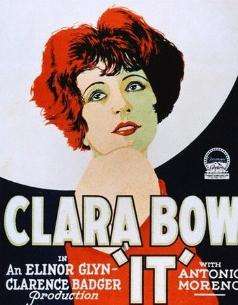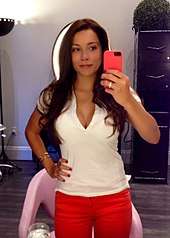It girl

An it girl is an attractive young woman, generally a celebrity, who is perceived to have both sex appeal and a personality that is especially engaging.[1]
The expression it girl originated in British upper-class society around the turn of the 20th century.[2] It reached global attention in 1927, with the popularity of the Paramount Studios film It, starring Clara Bow. In the earlier usage, a woman was especially perceived as an it girl if she had achieved a high level of popularity without flaunting her sexuality. Today the term is used more to apply simply to fame and beauty.
Early use
An early literary usage of it in this sense may be traced to a 1904 short story by Rudyard Kipling: It isn’t beauty, so to speak, nor good talk necessarily. It’s just ‘It’. [3]
Elinor Glyn, the notorious British novelist who wrote the book titled It and the subsequent screenplay, lectured
With It, you win all men if you are a woman and all women if you are a man. It can be a quality of the mind as well as a physical attraction.
— Elinor Glyn (1927)[4]
Glyn first rose to fame as the author of the scandalous 1907 bestseller Three Weeks. She is usually credited with the invention of the ‘It Girl’ concept: although the slang predates her book and film, she is definitely responsible for the impact the term had on the culture of the 1920s. Bow later said she wasn’t sure what “It” meant,[5] although she identified Lana Turner[5] and later Marilyn Monroe[6] as “It Girls”, and Robert Mitchum as an “It Man”.[5]
The fashion component of the It Girl, originated with the celebrated couturier Lucy, Lady Duff-Gordon, known professionally as “Lucile”, the name under which she directed exclusive salons in London, Paris and New York; she was Elinor Glyn’s elder sister. As Lucile, Lucy Duff-Gordon was the first designer to present her collections on a stage complete with the theatrical accoutrements of lights and music, inspiring the modern runway or catwalk show, and she was famous for making sexuality an aspect of fashion through her provocative lingerie and lingerie-inspired clothes.[7][8] Lucile also specialised in dressing trendsetting stage and film performers, ranging from the stars of the Ziegfeld Follies on Broadway to silent screen icons such as Mary Pickford and Irene Castle.
As early as 1917, Lucile herself used the term It in relation to style in her fashion column for Harper's Bazaar: "... I saw a very ladylike and well-bred friend of mine in her newest Parisian frock ... she felt she was 'it' and perfectly happy."[9][10]
It (1927 film)
The Paramount Studios' film was planned as a special showcase for its popular star Clara Bow, and her spectacular performance[11] introduced the term ‘It’ to the cultural lexicon. The film plays with the notion that "It" is a quality which eschews definitions and categories; consequently, the girl portrayed by Bow is an amalgam of an ingenue and a femme fatale, with a touch of Madonna's latter day "Material Girl" incarnation. By contrast, Bow's rival in the script is equally young and comely (and rich and well-bred to boot), yet she doesn't have "It".
Modern "It Girls"
Since the 1990s, It Girl or It-Girl has been used slightly differently, referring to a wealthy, normally unemployed, young woman who is pictured in tabloids going to many parties often in the company of other celebrities, receiving media coverage in spite of no real personal achievements or TV hosting / presenting. The writer William Donaldson observed that, having initially been coined in the 1920s, the term was applied in the 1990s to describe "a young woman of noticeable 'sex appeal' who occupied herself by shoe shopping and party-going".[12]
The prominence of an "It Girl" is often temporary; some of the rising It Girls will either become fully-fledged celebrities, commonly initially via engineering appearances on reality TV shows or series; lacking such an accelerant, their popularity will normally fade. Reflection on the celebrity-focused and celebrity-promoting nature of news media – particularly tabloid newspapers – may be helpful.
Film and theater
- Glyn's 1927 film script was adapted into a musical called The It Girl, which opened off-Broadway in 2001 at the York Theatre Company, starring Jean Louisa Kelly.[13]
- It Girls is a 2002 feature documentary film directed by Robin Melanie Leacock, which chronicles the activities of a group of socialites in Manhattan during New York Fashion Week.
Examples

- Tara Palmer-Tomkinson (1971–2017), English socialite and television personality, was considered to be the foremost of the 1990s It girls in the United Kingdom.[14]
- Edie Sedgwick (1943–1971), American actress, model, and Andy Warhol's muse, was dubbed the "It Girl".[15]
- Chloë Sevigny (b. 1974), American actress and model, was described as an "It Girl" by The New York Times editor Jay McInerney in 1993, because of her status as a fashion impresario.[16]
- Sara Schätzl (b. 1987), German writer and actress, was labelled an "It-Girl" by the German tabloid press in the late 2000s.[17][18]
See also
References
- ↑ "It girl". Dictionary.com unabridged. Retrieved June 19, 2018.
- ↑ Etherington-Smith, Meredith & Pilcher, Jeremy. (1986). The 'It' Girls, 241.
- ↑ Wilson, Alastair; Wilson, Commander Alastair (19 October 2010). "Mrs Bathurst". KiplingSociety.co.uk. Retrieved 5 March 2014.
... she had that indefinable quality which Kipling was the first to call ‘It’ – sex-appeal without flaunting her sexuality.
- ↑ Introduction in the film script for It (USA, 1927)
- 1 2 3 Waterloo Daily Courier, 21 September 1950
- ↑ Stenn, David (1988). Clara Bow: Runnin’ Wild. Doubleday. p. 272. ISBN 0-385-24125-9.
- ↑ Evans, Caroline. (2013). The Mechanical Smile, pp 34–36, 39–41
- ↑ Bigham, Randy Bryan. (2012). Lucile - Her Life by Design pp 23–31.
- ↑ Duff-Gordon, Lady (Lucile). (1917). The Last Word in Fashions. Harper's Bazaar, 63, October 1917
- ↑ Bigham, Randy Bryan. (2012). Lucile - Her Life by Design, 31, 275.
- ↑ private showing. (1927-01-01) Variety
- ↑ Donaldson, W. (2002) Brewer's Rogues, Villains and Eccentrics.
- ↑ It Girl Musical Archived 2005-10-14 at the Wayback Machine.
- ↑ Jackson, Marie; Harris, Dominic (2017-02-09). "Tara Palmer-Tomkinson and co: Whatever happened to the 'It girl'?". BBC News. Retrieved 2017-02-09.
- ↑ LiveJournal: Discover global communities of friends who share your unique passions and interests Archived 2011-07-23 at the Wayback Machine.
- ↑ McInerney, Jay (7 November 1994). "Chloe's Scene". The New Yorker. New York City: Condé Nast. Retrieved 13 May 2018.
- ↑ "It-Girl Sara Schätzl aus München Öffentlich bis zum Zusammenbruch". Süddeutsche Zeitung. 31 January 2012. Retrieved 2 July 2013.
- ↑ Schneider, Martin. "Sara Schätzl: Warnung vor dem Roten Teppich". Archived from the original on 14 July 2014. Retrieved 2 July 2013.
Further reading
- Morella, Joseph; Epstein, Edward Z. (1976). The "It" Girl: The Incredible Story of Clara Bow. New York: Delacorte Press. ISBN 0-440-14068-4.
- Evans, Caroline. (2013). The Mechanical Smile.
- Bigham, Randy Bryan. (2012). Lucile - Her Life by Design.
- Stenn, David (1988). Clara Bow: Runnin’ Wild. Doubleday. ISBN 0-385-24125-9.
- Brown, Leah Marie. (2015, 2016, 2017). The It Girls series. Books one: “Faking It” ISBN 1-616-50813-2 Book two: “Finding It” ISBN 1616508140. Book three: “Working It” ISBN 1616508159 Book four: “Owning It” ISBN 1516101227